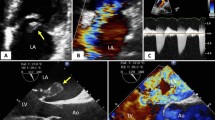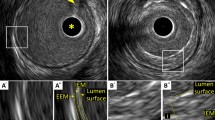Abstract
Objective
This study aims to compare an electrocardiogram (ECG)-gated four-dimensional (4D) phase-contrast (PC) magnetic resonance imaging (MRI) technique and computational fluid dynamics (CFD) using variables controlled in a laboratory environment to minimize bias factors.
Materials and methods
Data from 4D PC-MRI were compared with computational fluid dynamics using steady and pulsatile flows at various inlet velocities. Anatomically realistic models for a normal aorta, a penetrating atherosclerotic ulcer, and an abdominal aortic aneurysm were constructed using a three-dimensional printer.
Results
For the normal aorta model, the errors in the peak and the average velocities were within 5%. The peak velocities of the penetrating atherosclerotic ulcer and the abdominal aortic aneurysm models displayed a more extensive range of differences because of the high-speed and vortical fluid flows generated by the shape of the blood vessel. However, the average velocities revealed only relatively minor differences.
Conclusions
This study compared the characteristics of PC-MRI and CFD through a phantom study that only included controllable experimental parameters. Based on these results, 4D PC-MRI and CFD are powerful tools for analyzing blood flow patterns in vivo. However, there is room for future developments to improve velocity measurement accuracy.












Similar content being viewed by others
References
Fisher AB, Chien S, Barakat AI, Nerem RM (2001) Endothelial cellular response to altered shear stress. Am J Physiol Lung Cell Mol Physiol 281(3):L529–L533. https://doi.org/10.1152/ajplung.2001.281.3.L529
Ku DN, Giddens DP, Zarins CK, Glagov S (1985) Pulsatile flow and atherosclerosis in the human carotid bifurcation. Positive correlation between plaque location and low oscillating shear stress. Arteriosclerosis 5(3):293–302. https://doi.org/10.1161/01.ATV.5.3.293
Barker AJ, Markl M, Bürk J, Lorenz R, Bock J, Bauer S, Schulz-Menger J, von Knobelsdorff-Brenkenhoff F (2012) Bicuspid aortic valve is associated with altered wall shear stress in the ascending aorta. Circ Cardiovasc Imaging 5(4):457–466. https://doi.org/10.1161/CIRCIMAGING.112.973370
Bissell MM, Hess AT, Biasiolli L, Glaze SJ, Loudon M, Pitcher A, Davis A, Prendergast B, Markl M, Barker AJ, Neubauer S, Myerson SG (2013) Aortic dilation in bicuspid aortic valve disease: flow pattern is a major contributor and differs with valve fusion type. Circ Cardiovasc Imaging 6(4):499–507. https://doi.org/10.1161/CIRCIMAGING.113.000528
Uretsky S, Gillam LD (2014) Nature versus nurture in bicuspid aortic valve aortopathy: more evidence that altered hemodynamics may play a role. Circulation 129(6):622–624. https://doi.org/10.1161/CIRCULATIONAHA.113.007282
Slager CJ, Wentzel JJ, Gijsen FJH, Thury A, van der Wal AC, Schaar JA, Serruys PW (2005) The role of shear stress in the destabilization of vulnerable plaques and related therapeutic implications. Nat Rev Cardiol 2:456–464. https://doi.org/10.1038/ncpcardio0298
Groen HC, Gijsen FJH, van der Lugt A, Ferguson MS, Hatsukami TS, van der Steen AFW, Yuan C, Wentzel JJ (2007) Plaque rupture in the carotid artery is localized at the high shear stress region: a case report. Stroke 38:2379–2381. https://doi.org/10.1161/STROKEAHA.107.484766
Ha H, Huh H, Yang DH, Kim N (2019) Quantification of hemodynamic parameters using four-dimensional flow MRI. J Korean Soc Radiol 80:239–258. https://doi.org/10.3348/jksr.2019.80.2.239
Bollache E, van Ooij P, Powell A, Carr J, Markl M, Barker AJ (2016) Comparison of 4D flow and 2D velocity-encoded phase contrast MRI sequences for the evaluation of aortic hemodynamics. Int J Cardiovasc Imaging 32(10):1529–1541. https://doi.org/10.1007/s10554-016-0938-5
Stalder AF, Russe MF, Frydrychowicz A, Bock J, Hennig J, Markl M (2008) Quantitative 2D and 3D phase contrast MRI: optimized analysis of blood flow and vessel wall parameters. Magn Reson Med 60(5):1218–1231. https://doi.org/10.1002/mrm.21778
Pereira VM, Brina O, Bijlenga P, Bouillot P, Narata AP, Schaller K, Lovblad K-O, Ouared R (2014) Wall shear stress distribution of small aneurysms prone to rupture: a case-control study. Stroke 45:261–264. https://doi.org/10.1161/STROKEAHA.113.003247
Morbiducci U, Ponzini R, Rizzo G, Cadioli M, Esposito A, De Cobelli F, Del Maschio A, Montevecchi FM, Redaelli A (2009) In vivo quantification of helical blood flow in human aorta by time-resolved three-dimensional cine phase contrast magnetic resonance imaging. Ann Biomed Eng 37:516–531. https://doi.org/10.1007/s10439-008-9609-6
Kecskemeti S, Johnson K, Wu Y, Mistretta C, Turski P, Wieben O (2012) High resolution three-dimensional cine phase contrast MRI of small intracranial aneurysms using a stack of stars k-space trajectory. J Magn Reson Imaging 35(3):518–527. https://doi.org/10.1002/jmri.23501
Petersson S, Dyverfeldt P, Gårdhagen R, Karlsson M, Ebbers T (2010) Simulation of phase-contrast MRI intravoxel velocity standard deviation (IVSD) mapping. Magn Reson Med 64(4):1039–1046. https://doi.org/10.1002/mrm.22494
Zawawi MH, Saleha A, Salwa A, Hassan NH, Zahari NM, Ramli MZ, Muda ZC (2018) A review: fundamentals of computational fluid dynamics (CFD). AIP Conf Proc 2030(1):020252. https://doi.org/10.1063/1.5066893
Morris PD, van de Vosse FN, Lawford PV, Hose DR, Gunn JP (2015) “Virtual” (computed) fractional flow reserve: current challenges and limitations. JACC Cardiovasc Interv 8(8):1009–1017. https://doi.org/10.1016/j.jcin.2015.04.006
Simon HA, Ge L, Sotiropoulos F, Yoganathan AP (2010) Simulation of the three-dimensional hinge flow fields of a bileaflet mechanical heart valve under aortic conditions. Ann Biomed Eng 38:841–853. https://doi.org/10.1007/s10439-009-9857-0
Pennati G, Corsini C, Hsia T-Y, Migliavacca F, for the Modeling of Congenital Hearts Alliance (MOCHA) Investigators (2013) Computational fluid dynamics models and congenital heart diseases. Front Pediatr 1:4. https://doi.org/10.3389/fped.2013.00004
Chiu W-C, Girdhar G, Xenos M, Alemu Y, Soares JS, Einav S, Slepian M, Bluestein D (2014) Thromboresistance comparison of the HeartMate II ventricular assist device with the device thrombogenicity emulationoptimized HeartAssist 5 VAD. J Biomech Eng 136(2):021014. https://doi.org/10.1115/1.4026254
Dong J, Wong KKL, Tu J (2013) Hemodynamics analysis of patient-specific carotid bifurcation: a CFD model of downstream peripheral vascular impedance. Int J Numer Method Biomed Eng 29(4):476–491. https://doi.org/10.1002/cnm.2529
Cebral JR, Putman CM, Alley MT, Hope T, Bammer R, Calamante F (2009) Hemodynamics in normal cerebral arteries: qualitative comparison of 4D phase-contrast magnetic resonance and image-based computational fluid dynamics. J Eng Math 64(4):367–378. https://doi.org/10.1007/s10665-009-9266-2
Boussel L, Rayz V, Martin A, Acevedo-Bolton G, Lawton MT, Higashida R, Smith WS, Young WL, Saloner D (2009) Phase-contrast magnetic resonance imaging measurements in intracranial aneurysms in vivo of flow patterns, velocity fields, and wall shear stress: comparison with computational fluid dynamics. Magn Reson Med 61(2):409–417. https://doi.org/10.1002/mrm.21861
Boccadifuoco A, Mariotti A, Capellini K, Celi S, Salvetti MV (2018) Validation of numerical simulations of thoracic aorta hemodynamics: comparison with in vivo measurements and stochastic sensitivity analysis. Cardiovasc Eng Tech 9(4):688–706. https://doi.org/10.1007/s13239-018-00387-x
Miyazaki S, Itatani K, Furusawa T, Nishino T, Sugiyama M, Takehara Y, Yasukochi S (2017) Validation of numerical simulation methods in aortic arch using 4D flow MRI. Heart Vessels 32:1032–1044. https://doi.org/10.1007/s00380-017-0979-2
Cibis M, Potters WV, Gijsen FJH, Marquering H, vanBavel E, van der Steen AFW, Nederveen AJ, Wentzel JJ (2014) Wall shear stress calculations based on 3D cine phase contrast MRI and computational fluid dynamics: a comparison study in healthy carotid arteries. NMR Biomed 27:826–834. https://doi.org/10.1002/nbm.3126
Wentland AL, Grist TM, Wieben O (2013) Repeatability and internal consistency of abdominal 2D and 4D phase contrast MR flow measurements. Acad Radiol 20(6):699–704. https://doi.org/10.1016/j.acra.2012.12.019
Ebel S, Hübner L, Köhler B, Kropf S, Preim B, Jung B, Grothoff M, Gutberlet M (2019) Validation of two accelerated 4D flow MRI sequences at 3 T: a phantom study. Eur Radiol Exp 3(1):1–12. https://doi.org/10.1186/s41747-019-0089-2
Park J, Kim J, Chang Y, Youn SW, Lee HJ, Kang EJ, Lee KN, Suchánek V, Hyun S, Lee J (2019) Analysis of the time-velocity curve in phase-contrast magnetic resonance imaging: a phantom study. Comput Assist Surg 24:3–12. https://doi.org/10.1080/24699322.2019.1649066
Kim GB, Lee S, Kim H, Yang DH, Kim Y-H, Kyung YS, Kim C-S, Choi SH, Kim BJ, Ha H, Kwon SU, Kim N (2016) Three-dimensional printing: basic principles and applications in medicine and radiology. Korean J Radiol 17(2):182–197. https://doi.org/10.3348/kjr.2016.17.2.182
Chung TG, Kim YS, Chang Y, Lee SK, Kim YH, Ryeom HK, Lee JM, Lee CH, Kim TH, Suh KJ (2000) High signal intensity on T1-weighted MR image related to vacuum cleft in the intervertebral disk: clinical and phantom study. J Korean Radiol Soc 43:651–656. https://doi.org/10.3348/jkrs.2000.43.6.651
Segur JB, Oberstar HE (1951) Viscosity of glycerol and its aqueous solutions. Ind Eng Chem 43(9):2117–2120. https://doi.org/10.1021/ie50501a040
Volk A, Kähler CJ (2018) Density model for aqueous glycerol solutions. Exp Fluids 59(5):75. https://doi.org/10.1007/s00348-018-2527-y
Lotz J, Meier C, Leppert A, Galanski M (2002) Cardiovascular flow measurement with phase-contrast MR imaging: basic facts and implementation. Radiographics 22(3):651–671. https://doi.org/10.1148/radiographics.22.3.g02ma11651
Rosner B (2015) Fundamentals of biostatistics. Brookes/Cole, USA
Chandran KB, Rittgers SE, Yoganathan AP (2012) Biofluid mechanics: the human circulation. CRC Press, USA
Rajan KS, Pitchumani B, Srivastava SN, Mohanty B (2007) Two-dimensional simulation of gas–solid heat transfer in pneumatic conveying. Int J Heat Mass Transf 50(5–6):967–976. https://doi.org/10.1016/j.ijheatmasstransfer.2006.08.009
Frydrychowicz A, François CJ, Turski PA (2011) Four-dimensional phase contrast magnetic resonance angiography: potential clinical applications. Eur J Rad 80:24–35. https://doi.org/10.1016/j.ejrad.2011.01.094
van Ooij P, Schneiders JJ, Marquering HH, Majoie CB, van Bavel E, Nederveen AJ (2013) 3D cine phase-contrast MRI at 3T in intracranial aneurysms compared with patient-specific computational fluid dynamics. Am J Neurorad 34(9):1785–1791. https://doi.org/10.3174/ajnr.A3484
Ha H, Lantz J, Haraldsson H, Casas B, Ziegler M, Karlsson M, Saloner D, Dyverfelt P, Ebbers T (2016) Assessment of turbulent viscous stress using ICOSA 4D flow MRI for prediction of hemodynamic blood damage. Sci Rep 6:39773. https://doi.org/10.1038/srep39773
Lantz J, Ebbers T, Engvall J, Karlsson M (2013) Numerical and experimental assessment of turbulent kinetic energy in an aortic coarctation. J Biomech 46(11):1851–1858. https://doi.org/10.1016/j.jbiomech.2013.04.028
Ngo MT, Kim CI, Jung J, Chung GH, Lee DH, Kwak HS (2019) Four-dimensional flow magnetic resonance imaging for assessment of velocity magnitudes and flow patterns in the human carotid artery bifurcation: comparison with computational fluid dynamics. Diagnostics 9(4):223. https://doi.org/10.3390/diagnostics9040223
Kweon J, Yang DH, Kim GB, Kim N, Paek M, Stalder AF, Greiser A, Kim Y-H (2016) Four-dimensional flow MRI for evaluation of post-stenotic turbulent flow in a phantom: comparison with flowmeter and computational fluid dynamics. Eur Radiol 26(10):3588–3597. https://doi.org/10.1007/s00330-015-4181-6
Dyverfeldt P, Kvitting JPE, Sigfridsson A, Engvall J, Bolger AF, Ebbers T (2008) Assessment of fluctuating velocities in disturbed cardiovascular blood flow: in vivo feasibility of generalized phase-contrast MRI. J Magn Reson Imaging 28(3):655–663. https://doi.org/10.1002/jmri.21475
Box FM, van der Geest RJ, van der Grond J, van Osch MJ, Zwinderman AH, Palm-Meinders IH, Reiber JH (2007) Reproducibility of wall shear stress assessment with the paraboloid method in the internal carotid artery with velocity encoded MRI in healthy young individuals. J Magn Reson Imaging 26(3):598–605. https://doi.org/10.1002/jmri.21086
Dyverfeldt P, Bissell M, Barker AJ, Bolger AF, Carlhäll CJ, Ebbers T, Markl M (2015) 4D flow cardiovascular magnetic resonance consensus statement. J Cardiovas Magn Reson 17(1):1–19. https://doi.org/10.1186/s12968-015-0174-5
Funding
This research received no specific grant from any funding agency in the public, commercial, or not-for-profit sectors.
Author information
Authors and Affiliations
Corresponding authors
Ethics declarations
Conflict of interest
No potential conflict of interest was reported by the authors.
Ethical approval
All procedures performed in studies involving human participants were in accordance with the ethical standards of the institutional and national research committee and with the 1964 Helsinki declaration and its later amendments or comparable ethical standards.
Informed consent
The study was approved by the institutional review board (IRB) of the Kyungpook National University (KNU 2018-0175), and the IRB exempted consent from the patients, given that it was a retrospective study.
Additional information
Publisher's Note
Springer Nature remains neutral with regard to jurisdictional claims in published maps and institutional affiliations.
Rights and permissions
About this article
Cite this article
Park, J., Kim, J., Hyun, S. et al. Hemodynamics in a three-dimensional printed aortic model: a comparison of four-dimensional phase-contrast magnetic resonance and image-based computational fluid dynamics. Magn Reson Mater Phy 35, 719–732 (2022). https://doi.org/10.1007/s10334-021-00984-3
Received:
Revised:
Accepted:
Published:
Issue Date:
DOI: https://doi.org/10.1007/s10334-021-00984-3




